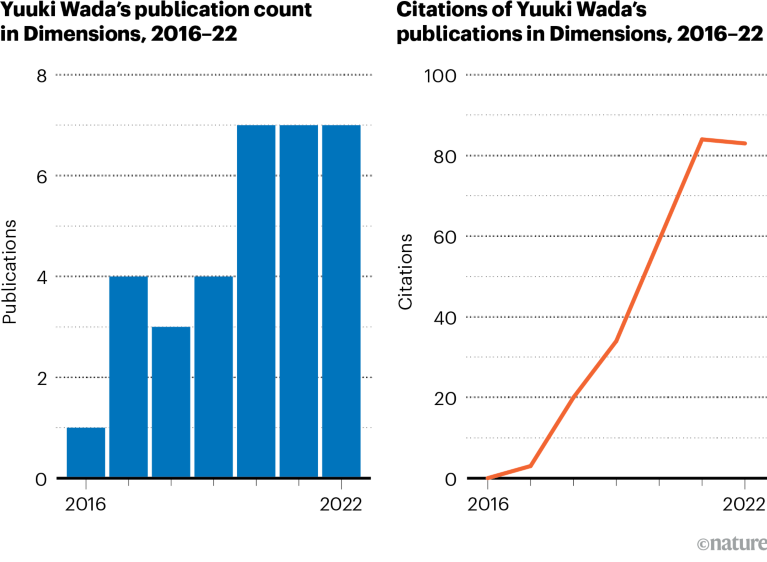
Yuuki Wada studies γ-rays on Earth to better understand the origins of high-energy rays emitted by distant objects such as black holes.Credit: Irwin Wong for Nature
This is the second in a Nature Index series of profiles about emerging early-careers researchers in Japan.
As a high-energy physicist, Yuuki Wada once spent most of his time pondering black holes, neutron stars and supernovae. But lately he’s turned his attention to phenomena closer to home: the low, fat clouds that travel towards Japan’s coastline. Amazingly, thunder clouds often have something in common with extreme celestial objects. Specifically, they have the power to generate γ-rays, the highest-energy wave in the electromagnetic spectrum. It’s not clear, however, exactly how tempestuous weather on Earth is able to produce this radiation.
Wada, a physicist with the Extreme Natural Phenomena RIKEN Hakubi Research Team in Saitama, Japan, is part of a group of researchers who track γ-rays in thunderstorms to better understand the source of the rays and the innate power of thunderstorms.
Scientists can create γ-rays with the help of accelerators that hurl particles through a vacuum, but thunderstorms somehow mimic that feat in an ultra-thick atmosphere roiling with water vapour.
“The strong electrical field inside a thunderstorm is thought to accelerate electrons to relativistic levels,” Wada says, which means the electrons approach the speed of light. “How that happens in a thick atmosphere is a complete mystery.”
Chasing storms has proved to be a successful scientific strategy. Wada co-authored nine publications tracked by the Nature Index from 2016 to 2021, a figure that puts him in the top five for early-career researchers in Earth and environmental sciences in Japan.
Wada and his colleagues mainly focus their γ-ray detectors on the winter thunderclouds that roll on to the northwest shore of the central island of Honshu from October to March. Unlike lofty summer storms that tend to stay at least 3 kilometres above ground, the winter storms hang low, well within reach of the detectors. Japan is well situated, Wada says, to receive powerful, frequent storms that travel down from Siberia and across the Sea of Japan.
Several years ago, he and his team did try to detect γ-rays in higher-altitude storms around Mount Fuji, but the physicists were stymied by a lack of electrical power. “We struggled to find outlets for our γ-ray detectors,” Wada says. He has no plans to try chasing mountain storms again any time soon as he still has plenty to learn from the accessible thunderclouds along the coast.
Many thunderstorms produce lingering γ-rays, but Wada is more interested in the much rarer terrestrial γ-ray flashes (TGFs), super-intense millisecond bursts of energy that are sometimes called dark lightning. Satellites frequently detect TGFs shooting up from thunderstorms into space, but it takes luck and perseverance to find γ-ray bursts that jump from clouds down to Earth. “TGFs are a very rare phenomenon so we need more observations,” he says.

Source: Dimensions
In 2022, Wada co-authored a study that documented seven such downward flashes in four winter seasons (Y. Wada et al. Geophys. Res. Lett. 49, e2021GL097348; 2022). In addition to γ-ray sensors, Wada and his colleagues tracked the flashes with broadband monitors, devices that measure their radio frequency. Each flash fell in the low-frequency range of less than 500 kilohertz, but a closer look revealed that flashes seem to come in at least two different varieties. Some of them have a maximum electrical current of approximately 50 kiloamperes, whereas others peak at more than 100 kiloamperes; yet one more nuance to TGFs that is yet to be explained.
All seven γ-ray flashes occurred within 600 microseconds of a bolt of lightning, and Wada suspects this isn’t just a coincidence. One of his top priorities is to understand the link between γ-ray radiation and the more familiar bright flashes of lightning across the sky that we’re used to seeing with the naked eye. “Our hypothesis is that γ-rays in thunderstorms can facilitate the triggering of lightning,” he says.
Studying γ-rays on Earth might offer insights into the origin and behaviour of high-energy rays emitted by more distant objects such as black holes, supernovae and neutron stars.
Wada notes that γ-rays often accelerate through the atmospheres surrounding these celestial objects, so studying rays flashing through Earth’s atmosphere could further the understanding of cosmic events. But as those thunderstorms approach, Wada’s attention is entirely focused on earthly matters. “Lightning is beautiful and high-energy particles are very mysterious,” he says.


 Is Japan’s research decline turning a corner?
Is Japan’s research decline turning a corner?
 How Japanese science is trying to reassert its research strength
How Japanese science is trying to reassert its research strength
 Japan’s leading international partnerships
Japan’s leading international partnerships
 Freeing up Japan’s PhD potential
Freeing up Japan’s PhD potential
 Japan’s rising research stars: Mariko Kimura
Japan’s rising research stars: Mariko Kimura
 Japan’s rising research stars: Tatsuya Kubota
Japan’s rising research stars: Tatsuya Kubota
 Japan’s rising research stars: Yasuka Toda
Japan’s rising research stars: Yasuka Toda
 Japan’s rising research stars: Ken-ichi Otake
Japan’s rising research stars: Ken-ichi Otake
 Will Japan’s new ¥10-trillion university fund lift research performance?
Will Japan’s new ¥10-trillion university fund lift research performance?
 Shoring up Japan’s research performance
Shoring up Japan’s research performance
 How Japan’s disciplinary strengths are shifting focus
How Japan’s disciplinary strengths are shifting focus
 Japanese robotics lags as AI captures global attention
Japanese robotics lags as AI captures global attention





